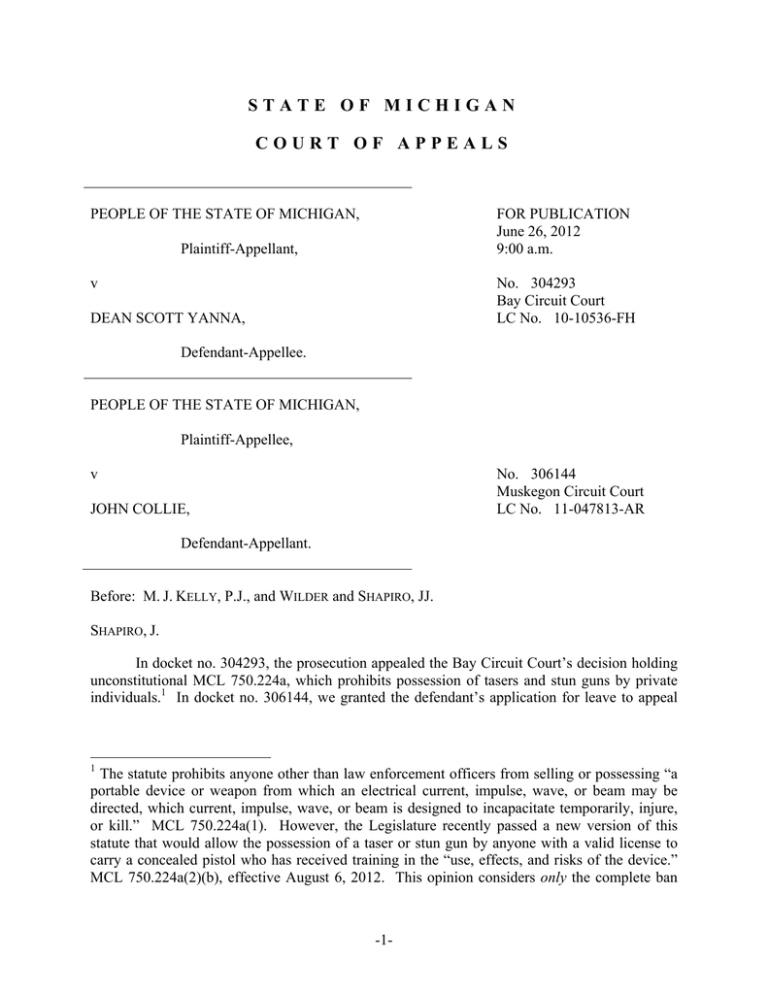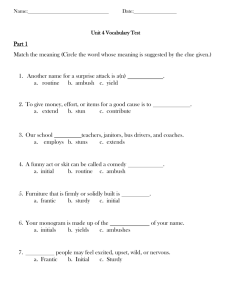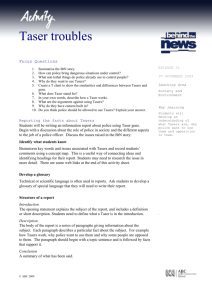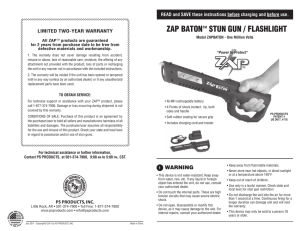Michigan Appeals Court Ruling on Stun Guns
advertisement

STATE OF MICHIGAN COURT OF APPEALS PEOPLE OF THE STATE OF MICHIGAN, FOR PUBLICATION June 26, 2012 9:00 a.m. Plaintiff-Appellant, v No. 304293 Bay Circuit Court LC No. 10-10536-FH DEAN SCOTT YANNA, Defendant-Appellee. PEOPLE OF THE STATE OF MICHIGAN, Plaintiff-Appellee, v No. 306144 Muskegon Circuit Court LC No. 11-047813-AR JOHN COLLIE, Defendant-Appellant. Before: M. J. KELLY, P.J., and WILDER and SHAPIRO, JJ. SHAPIRO, J. In docket no. 304293, the prosecution appealed the Bay Circuit Court’s decision holding unconstitutional MCL 750.224a, which prohibits possession of tasers and stun guns by private individuals.1 In docket no. 306144, we granted the defendant’s application for leave to appeal 1 The statute prohibits anyone other than law enforcement officers from selling or possessing “a portable device or weapon from which an electrical current, impulse, wave, or beam may be directed, which current, impulse, wave, or beam is designed to incapacitate temporarily, injure, or kill.” MCL 750.224a(1). However, the Legislature recently passed a new version of this statute that would allow the possession of a taser or stun gun by anyone with a valid license to carry a concealed pistol who has received training in the “use, effects, and risks of the device.” MCL 750.224a(2)(b), effective August 6, 2012. This opinion considers only the complete ban -1- from the Muskegon Circuit Court’s order holding the same statute constitutional. Given the identical questions posed by these cases, we have consolidated them.2 We hold that the version of MCL 750.224a at issue in these cases is unconstitutional. The Michigan and United States Constitutions protect a citizen’s right to possess and carry tasers or stun guns for self-defense, and the state may not completely prohibit their use by private citizens. I. FACTS The facts of docket no. 304293 are not disputed. On Saturday June 5, 2010, Bay City Police “received an anonymous telephone call advising them that defendant was working behind the counter at Old Town Party Store with a taser in his belt.” Officers responded to the party store and observed defendant Yanna working behind the counter. Upon request, Yanna removed a stun gun3 from his belt and turned it over to the police. The stun gun was transported back to the police department where it was tested. The stun gun appeared to be fully operational and was tagged and secured into evidence. Yanna was charged with possession of a stun gun in violation of MCL 750.224a, and with being a third habitual offender. Yanna filed a motion to dismiss, arguing that MCL 750.224a violated his right to keep and bear arms as provided for in both the federal and Michigan constitutions. The parties stipulated “for the purposes of arguing and deciding the constitutional issues . . . that the stun gun discharges an electrical current that could temporarily incapacitate or incapacitate but is generally nonlethal.” On April 21, 2011, the trial court issued an opinion and order granting defendant’s motion to dismiss. The facts of docket no. 306144 are equally undisputed. According to the police report, on February 4, 2011, defendant Collie called the Muskegon Police Department and said that he needed his insulin medication but his wife would not let him in the house. A police officer arrived to assist Collie in getting his insulin and some other personal belongings. When the officer arrived, Collie informed the officer that his wife had told him that she wanted a divorce and took his house key. After the officer spoke to Collie’s wife, she opened the door and Collie began gathering his things. Collie then said he needed one more thing, and he called it a “toy.” He began looking for the item and his wife held up a stun gun and asked if that was what he was looking for. He said it was what he wanted, but the officer took custody of it. In his report, the officer stated that “[t]he Stun Gun when activated, displayed an approximately 1 inch long white/blue electrical current with a loud, intimidating crackling sound.” implemented by the statute under which defendant was arrested, not the partial ban of the new statute. 2 Because this case involves the constitutionality of a state statute, following oral argument we issued an order inviting the Attorney General to file a brief on that issue. The Attorney General declined to do so. 3 The term taser generally applies to a device that delivers an electric charge through barbs that can be propelled several feet away and penetrate clothing or skin. By contrast, a stun gun must be held in direct contact with the target. -2- Collie was charged with possession of a stun gun and with being a fourth habitual offender. Collie filed a motion to dismiss in the district court, arguing that MCL 750.224a was unconstitutional. He argued that possession of a stun gun within one’s home was protected under the Second Amendment. The district court agreed and dismissed the charges, but the circuit court reversed this decision on appeal. Collie applied for and received leave to appeal the circuit court’s decision. II. ANALYSIS This Court reviews de novo issues of constitutional construction. Dep’t of Transp v Tomkins, 481 Mich 184, 190; 749 NW2d 716 (2008). The Second Amendment provides: “A well regulated Militia, being necessary to the security of a free State, the right of the people to keep and bear Arms, shall not be infringed.” In DC v Heller, 554 US 570; 128 S Ct 2783; 171 L Ed 2d 637 (2008), the court held that the Second Amendment “guarantee[s] the individual the right to possess and carry weapons in case of confrontation.” 554 US at 592. The Second Amendment is fully applicable to the states through the Fourteenth Amendment. McDonald v City of Chicago, 130 S Ct 3020, 3050; 177 L Ed 2d 894 (2010). Further, Heller’s formulation appears to be equivalent to the provision in Const 1963, art 1, § 6, which states, “Every person has a right to keep and bear arms for the defense of himself and the state.” Both provisions grant individuals a right to keep and bear arms for self-defense. We will refer only to the Second Amendment for simplicity. There are several issues to be considered. The first question is whether the objects banned by MCL 750.224a constitute “arms,” such that they come within the ambit of the Second Amendment. This question must be answered in the affirmative. Heller stated: The 18th-century meaning is no different from the meaning today. The 1773 edition of Samuel Johnson's dictionary defined “arms” as “weapons of offence, or armour of defence.” 1 Dictionary of the English Language 106 (4th ed.) (reprinted 1978) (hereinafter Johnson). Timothy Cunningham's important 1771 legal dictionary defined “arms” as “any thing that a man wears for his defence, or takes into his hands, or useth in wrath to cast at or strike another.” [554 US at 581]. Stun guns may be used both for defense or “to cast at or strike another.” Therefore, MCL 750.224a does impact “arms.” “[T]he Second Amendment extends, prima facie, to all instruments that constitute bearable arms, even those that were not in existence at the time of the founding.” 554 US at 582. Plaintiff argues that Heller is strictly a gun control case, but the broad nature of the language used in Heller’s definition of arms clearly covers more than just firearms. Heller did recognize certain limitations on the right to keep and bear arms. In some respects, these limitations are consistent with each other. However, they are not identical and the US Supreme Court neither fully harmonized them nor elevated one over another. First, the Court stated that “the Second Amendment does not protect those weapons not typically possessed by law-abiding citizens for lawful purposes.” 554 US at 625. The Court further stated that “the -3- sorts of weapons protected were those ‘in common use at the time.’” Id. at 627. As noted above, however, this included weapons that did not exist when the Second Amendment was enacted. Id. at 582. Third, the Court referred to “the historical tradition of prohibiting the carrying of ‘dangerous and unusual weapons.’” Id. at 627. The prosecution argues that stun guns are not suited for lawful defensive purposes, and that they can easily be used for torturing someone tied to a chair or incapacitating an unsuspecting victim. This argument is unavailing. One could easily produce an even lengthier list of criminal cases involving handguns, but the Supreme Court has determined that handguns are within the ambit of the Second Amendment. Hundreds of thousands of tasers and stun guns have been sold to private citizens, with many more in use by law enforcement officers. Eugene Volokh, Nonlethal Self-Defense, (Almost Entirely) Nonlethal Weapons, and the Rights to Keep and Bear Arms and Defend Life, 62 Stan L Rev 199, 206 n 28, 212 (2009).4 The prosecution fails to put forth evidence that would give the Court reason to doubt that the vast majority of tasers and stun guns are possessed by law-abiding citizens for lawful purposes. This Court previously upheld MCL 750.224a in People v Smelter, 175 Mich App 153; 437 NW2d 341 (1989), apparently finding that the weapons covered by the statute were customarily employed to violate the law. Id. at 155. However, the only fact cited in Smelter was the capacity of the weapon seized from the defendant to temporarily incapacitate or even temporarily paralyze someone. Smelter did not cite any evidence that tasers or stun guns are regularly used by criminals. Smelter cited People v Brown, 253 Mich 537; 235 NW 245 (1931), but the Brown court specifically noted that the statute at issue prohibited “a partial inventory of the arsenal of the ‘public enemy,’ the ‘gangster.’” 253 Mich at 542. Discussing blackjacks, the court cited the Encyclopaedia Britannica, which described blackjacks as “’a characteristic weapon of urban gangsters and rowdies.’” Id. Aside from the lack of factual support cited for Smelter’s conclusion, the legal and factual landscape has altered in the last 23 years. By some reports, nearly 95% of police departments in America use tasers.5 Further, Smelter predates Heller. While the Smelter decision is entitled to some deference, it is not binding on this Court. MCR 7.215(J)(1). Because we have no reason to doubt that the majority of tasers and stun guns are used only for lawful purposes, we decline to follow Smelter. The prosecution also argues that stun guns and tasers are so dangerous that they are not protected by the Second Amendment. However, it is difficult to see how this is so since Heller concluded that handguns are not sufficiently dangerous to be banned. Tasers and stun guns, 4 Volokh’s article cites a newspaper article from 1985 reporting that more than 300,000 “stun guns” had already been sold to police and civilians. 5 Quentin Hardy, “Taser’s Latest Police Weapon: The Tiny Camera and the Cloud,” NY Times, February 21, 2012. Accessed June 5, 2012, at: http://www.nytimes.com/2012/02/21/technology/tasers-latest-police-weapon-the-tiny-cameraand-the-cloud.html?pagewanted=1&ref=stunguns. (Taser Int’l president claims tasers “are used by 17,000 of the 18,000 law enforcement agencies in the United States.”) -4- while plainly dangerous, are substantially less dangerous than handguns. Therefore, tasers and stun guns do not constitute “dangerous” weapons for purposes of Second Amendment inquiries. The prosecution also argues that tasers and stun guns “unusual” or rare weapons. However, they are legal in forty-three states, and in Michigan are routinely used by law enforcement officers. They have been in use for several decades. Though far less prevalent than handguns, we do not think that stun guns or tasers may be fairly labeled as unusual weapons. Because tasers and stun guns do not fit any of the exceptions to the Second Amendment enumerated in Heller, we find that they are protected arms. Heller found unconstitutional a law which completely banned the possession of protected arms in the home. 554 US at 628-629. We therefore hold that a complete ban on tasers and stun guns in the home violates the Second Amendment. The next question is whether the protected status of these arms makes unconstitutional a complete ban on carrying them in public. Heller specifically addressed only a full ban of protected weapons inside the home, not in public. Further, the analysis in Heller focused in part on the unmatched popularity of handguns for self-defense, and did not make clear to what extent greater restrictions could be applied to less popular weapons. On the other hand, Heller states that concealed weapons may be banned, but makes no such statement regarding openly carried arms. 554 US at 626-627. Indeed, Heller cites with approval two state cases that struck down laws prohibiting the public carrying of hand guns. Id. at 629. The Second Amendment explicitly protects the right to “carry” as well as the right to “keep” arms. Likewise, the Michigan Constitution specifically allows citizens to “bear” arms for self-defense. We therefore conclude that a total prohibition on the open carrying of a protected arm such as a taser or stun gun is unconstitutional. Statutes are presumed to be constitutional unless their unconstitutionality is clearly apparent, and must be construed as constitutional if possible. City of Owosso v Pouillon, 254 Mich App 210, 213; 657 NW2d 538 (2002). However, MCL 750.224a completely bans possession of tasers and stun guns by private citizens in public and in the home, and cannot be read to contain exceptions. We conclude that the statute is unconstitutional. We therefore affirm the Bay Circuit Court decision dismissing the charges against Yanna, and we reverse the order of the Muskegon Circuit Court and reinstate the district court order dismissing the charges against Collie. /s/ Douglas B. Shapiro /s/ Michael J. Kelly /s/ Kurtis T. Wilder -5-


